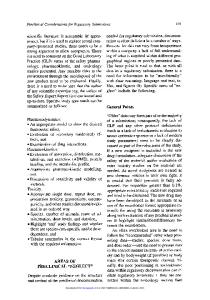Scientific and Regulatory Considerations for Development and Commercialization of Poorly Water-Soluble Drugs
This chapter focuses on the Chemistry, Manufacturing, and Controls (CMC) from the scientific and regulatory perspective of the development of poorly water-soluble drugs to provide insights into regulatory filing from Investigational New Drug Application (
- PDF / 905,856 Bytes
- 27 Pages / 439.37 x 666.14 pts Page_size
- 82 Downloads / 344 Views
Scientific and Regulatory Considerations for Development and Commercialization of Poorly Water-Soluble Drugs Zedong Dong and Hasmukh Patel
Abstract This chapter focuses on the Chemistry, Manufacturing, and Controls (CMC) from the scientific and regulatory perspective of the development of poorly water-soluble drugs to provide insights into regulatory filing from Investigational New Drug Application (IND) to New Drug Application (NDA) submission. The chapter includes two primary sections to cover the two regulatory stages for CMC module of filing, IND and NDA. The IND section of the chapter includes the following contents: (1) brief description of general filing requirements as outlined in the Code of Federal Regulations (CFR) and relevant guidances; (2) discussion of potential regulatory issues for developing poorly water-soluble drugs using various pharmaceutical technologies in the IND stage, i.e., solid-form selection, particle-size reduction, lipid formulation, and amorphous solid dispersion. The NDA section of the chapter includes the following: (1) general regulatory filing requirements of an NDA application; (2) potential regulatory issues associated with poorly water-soluble drugs; detailed discussions are carried out on topics including solid-form selection of the drug substance, drug product development using novel pharmaceutical technologies, development of control strategies, etc.; (3) case studies of marketed drug products of poorly water-soluble drugs in various dosage forms; this part uses the public information of the approved products as examples to support the discussions as outlined in part (2); and (4) brief discussion on the concept of Biopharmaceutics Classification System (BCS) in the development of poorly soluble drugs. The book chapter concludes with a brief summary which emphasizes on the link between regulation and science. Keywords Target identification • Validation • Pharmacophore • Leads selection • Investigation • Preformulation characterization • Formulation development • Safety • Clinical trials • Commercialization • Drug product manufacturing • Biopharmaceutics Classification System (BCS) • Drug–polymer dispersion system • Dissolution testing • Genotoxic impurities
Z. Dong (*) • H. Patel Office of Pharmaceutical Quality, Food and Drug Administration, 10903 New Hampshire Avenue, Silver Spring, MD 20993, USA e-mail: [email protected]; [email protected] © American Association of Pharmaceutical Scientists 2016 R.O. Williams III et al. (eds.), Formulating Poorly Water Soluble Drugs, AAPS Advances in the Pharmaceutical Sciences Series 22, DOI 10.1007/978-3-319-42609-9_14
741
742
14.1
Z. Dong and H. Patel
Introduction
The drug-development process is a multidisciplinary effort, from therapeutic target identification and validation (Lowe et al. 2009), lead series selection and structural optimization, preformulation characterization (Borchardt et al. 2004) and formulation development, process development for both the drug substance and drug product, nonclinical safety assessmen
Data Loading...











